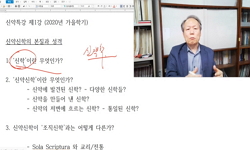본 논문의 목적은 무엇보다도 신학적 의미로서의 “영광”에 대한 연구에 있다. 따라서 신학의 근간이 되는 성경을 통하여 그 의미를 파악하려 시도하였다. 특히 요한 복음서는 다른 신약 ...
http://chineseinput.net/에서 pinyin(병음)방식으로 중국어를 변환할 수 있습니다.
변환된 중국어를 복사하여 사용하시면 됩니다.
- 中文 을 입력하시려면 zhongwen을 입력하시고 space를누르시면됩니다.
- 北京 을 입력하시려면 beijing을 입력하시고 space를 누르시면 됩니다.
요한복음서에 따른 '영광'(δόξα)에 관한 성서 신학적 고찰 = (A) Biblical-Theological Study on 'Glory' Based on the Gospel according to John
한글로보기https://www.riss.kr/link?id=T10877127
- 저자
-
발행사항
광주 : 光州가톨릭大學校 大學院, 2006
-
학위논문사항
학위논문(석사) -- 광주가톨릭대학교 대학원 , 성서신학전공 , 2007. 2
-
발행연도
2006
-
작성언어
한국어
- 주제어
-
KDC
233.65 판사항(4)
-
발행국(도시)
광주
-
형태사항
91p. ; 27cm
-
일반주기명
참고문헌: p. 81-88
- 소장기관
-
0
상세조회 -
0
다운로드
부가정보
국문 초록 (Abstract)
먼저 구약성경에서 인간의 영광은 훌륭한 사람이나 재력을 가진 사람 또는 왕처럼 위대한 사람이 지닌 권위와 명예를 가리킨다. 그러나 여기서 결코 간과할 수 없는 점은 이러한 영광이 인간이 아닌 야훼 하느님으로부터 연유되는 인간적인 존귀와 명예라는 것이다. 따라서 인간은 하느님의 이름에 합당한 영광을 야훼 하느님께 돌려야 한다는 것을 시사한다. 반면에 야훼 하느님의 영광은 자연과 역사 안에서 신적인 현현(Theophania)을 통하여 사람들에게 하느님의 현존을 체험할 수 있게 한다. 그래서 야훼 하느님의 영광은 하느님의 사랑과 성실성을 드러내는 하느님의 힘이며, 바로 종교적 소망이며, 종말론적 구원과 밀접한 상관 관계가 있다.
요한복음서도 마찬가지로 영광을 특히 예수 그리스도와 관련하여 독특하게 언급하면서 동시에 하느님의 영광을 빼놓지 않는다. 요한복음서에서 전하는 하느님의 영광은 육화한 말씀, 곧 예수 그리스도에게 드러나는 영광이다. 따라서 하느님의 영광을 구체적이고 실제적으로 드러내 보이신 예수 그리스도의 생애에서 드러난 영광을 살펴볼 필요가 있다.
예수 그리스도의 영광은 여러 호칭들(독생자, 사람의 아들)을 통하여 알 수 있듯이 천상적인 기원, 즉 선재신학적 이해선상에서 파악될 수 있다. 이제 예수 그리스도는 창조 이전부터 아버지 하느님 곁에서 누리던 영광을 당신 안에서 아버지 하느님의 현존을 드러내며 발산하게 되고, 이와 함께 아버지 하느님의 영광 또한 가장 완전하고 풍요롭게 알려주게 된다. 그리고 예수 그리스도의 구원 업적들(표징, 일, 말씀)은 그 영광을 발산하는 수단이요 매개체가 된다.
그러나 예수 그리스도는 당신의 천상적인 영광을 다시 누리기 전에 사람들이 하느님의 아들로 인정하고 고백하기 어려울 정도로 비천한 상태를 거쳐야 했다. 또한 세상에 영원한 생명을 주시기 위하여 당신의 살과 피를 희생물로 바쳐야 했다. 그래서 예수 그리스도는 십자가에 달리지만, 이는 예수 그리스도의 모든 구원 업적들의 종착지이며 완성으로서 단순한 고통과 치욕의 도구가 아닌 하느님의 영광의 예고이며, 하느님의 영광에로의 참여였다. 그리고 부활을 통하여 그 영광을 이 세상 안에 결정적으로 나타낸다. 결국 십자가와 부활을 통해서 예수 그리스도의 신비가 남김없이 계시된 것이다. 그렇기 때문에 아버지 하느님의 외아들이며 사람의 아들인, 그리고 선재한 예수 그리스도의 영광은 하느님의 유일한 계시자요, 참된 하느님으로 불리게 하며 당신을 믿는 모든 이를 종말에 완성될 구원에로 초대하는 것이다.
이러한 하느님과 예수 그리스도의 영광은 성령을 통한 제자들(믿음의 공동체)의 활동으로 인해 계속 결실을 맺음으로써 더욱더 드러나게 된다. 즉 제자들이 성령과 더불어 예수 그리스도의 이름으로 기도하고 하느님의 사랑을 실천함으로써 아버지 하느님은 아들 예수 그리스도 안에서 영광스럽게 되시는 것이다.
이제 이 영광은 현시대를 살아가고 있는 교회에 담겨져 있다. 교회는 그리스도로부터 위임받은 직무를 수행하면서 하느님께 영광을 드려야 한다. 따라서 현교회 안에서 살아가고 있는 그리스도인의 영광은 무엇보다 예수 그리스도 안에서 성령을 통해 완성된 하느님의 업적을 깨닫고 받아드리며, 또한 사람들이 전 생애를 통해 그 업적들을 드러내는 것이다. 이를 통하여 예수 그리스도가 약속한 구원의 완성에 참여할 수 있다. 이것이 곧 하느님 영광의 완성이다.
본 논문의 목적은 무엇보다도 신학적 의미로서의 “영광”에 대한 연구에 있다. 따라서 신학의 근간이 되는 성경을 통하여 그 의미를 파악하려 시도하였다. 특히 요한 복음서는 다른 신약 성경들 보다 “영광”에 대하여 많은 언급을 하고 있다. 일반적으로 요한 복음서를 ‘표징의 책’(1-12장)과 ‘영광의 책’(13-21장)으로 구분하는 점에서도 잘 알 수 있다. 따라서 요한 복음서를 중심으로 “영광”의 개념이 지닌 신학적인 의미를 탐구하고자 하였다.
먼저 구약성경에서 인간의 영광은 훌륭한 사람이나 재력을 가진 사람 또는 왕처럼 위대한 사람이 지닌 권위와 명예를 가리킨다. 그러나 여기서 결코 간과할 수 없는 점은 이러한 영광이 인간이 아닌 야훼 하느님으로부터 연유되는 인간적인 존귀와 명예라는 것이다. 따라서 인간은 하느님의 이름에 합당한 영광을 야훼 하느님께 돌려야 한다는 것을 시사한다. 반면에 야훼 하느님의 영광은 자연과 역사 안에서 신적인 현현(Theophania)을 통하여 사람들에게 하느님의 현존을 체험할 수 있게 한다. 그래서 야훼 하느님의 영광은 하느님의 사랑과 성실성을 드러내는 하느님의 힘이며, 바로 종교적 소망이며, 종말론적 구원과 밀접한 상관 관계가 있다.
요한복음서도 마찬가지로 영광을 특히 예수 그리스도와 관련하여 독특하게 언급하면서 동시에 하느님의 영광을 빼놓지 않는다. 요한복음서에서 전하는 하느님의 영광은 육화한 말씀, 곧 예수 그리스도에게 드러나는 영광이다. 따라서 하느님의 영광을 구체적이고 실제적으로 드러내 보이신 예수 그리스도의 생애에서 드러난 영광을 살펴볼 필요가 있다.
예수 그리스도의 영광은 여러 호칭들(독생자, 사람의 아들)을 통하여 알 수 있듯이 천상적인 기원, 즉 선재신학적 이해선상에서 파악될 수 있다. 이제 예수 그리스도는 창조 이전부터 아버지 하느님 곁에서 누리던 영광을 당신 안에서 아버지 하느님의 현존을 드러내며 발산하게 되고, 이와 함께 아버지 하느님의 영광 또한 가장 완전하고 풍요롭게 알려주게 된다. 그리고 예수 그리스도의 구원 업적들(표징, 일, 말씀)은 그 영광을 발산하는 수단이요 매개체가 된다.
그러나 예수 그리스도는 당신의 천상적인 영광을 다시 누리기 전에 사람들이 하느님의 아들로 인정하고 고백하기 어려울 정도로 비천한 상태를 거쳐야 했다. 또한 세상에 영원한 생명을 주시기 위하여 당신의 살과 피를 희생물로 바쳐야 했다. 그래서 예수 그리스도는 십자가에 달리지만, 이는 예수 그리스도의 모든 구원 업적들의 종착지이며 완성으로서 단순한 고통과 치욕의 도구가 아닌 하느님의 영광의 예고이며, 하느님의 영광에로의 참여였다. 그리고 부활을 통하여 그 영광을 이 세상 안에 결정적으로 나타낸다. 결국 십자가와 부활을 통해서 예수 그리스도의 신비가 남김없이 계시된 것이다. 그렇기 때문에 아버지 하느님의 외아들이며 사람의 아들인, 그리고 선재한 예수 그리스도의 영광은 하느님의 유일한 계시자요, 참된 하느님으로 불리게 하며 당신을 믿는 모든 이를 종말에 완성될 구원에로 초대하는 것이다.
이러한 하느님과 예수 그리스도의 영광은 성령을 통한 제자들(믿음의 공동체)의 활동으로 인해 계속 결실을 맺음으로써 더욱더 드러나게 된다. 즉 제자들이 성령과 더불어 예수 그리스도의 이름으로 기도하고 하느님의 사랑을 실천함으로써 아버지 하느님은 아들 예수 그리스도 안에서 영광스럽게 되시는 것이다.
이제 이 영광은 현시대를 살아가고 있는 교회에 담겨져 있다. 교회는 그리스도로부터 위임받은 직무를 수행하면서 하느님께 영광을 드려야 한다. 따라서 현교회 안에서 살아가고 있는 그리스도인의 영광은 무엇보다 예수 그리스도 안에서 성령을 통해 완성된 하느님의 업적을 깨닫고 받아드리며, 또한 사람들이 전 생애를 통해 그 업적들을 드러내는 것이다. 이를 통하여 예수 그리스도가 약속한 구원의 완성에 참여할 수 있다. 이것이 곧 하느님 영광의 완성이다.
다국어 초록 (Multilingual Abstract)
First of all, in the Old Testament the glory of man refers to a respectable person or to a wealthy person or to a great person who has power and honor like a king. But the point which we cannot fail to notice is that these glories are referred to as human nobility and human honor but are actually derived from Yahweh God and not from man. Therefore, it is suggested that man should return the glory which is proper to God to Yahweh God. The glory of Yahweh God also enables man to experience God's presence through a godly manifestation (theophania) in nature and history. So the glory of Yahweh God is the power of God shown through his love and faithfulness, is religious hope, is eschatological redemption and is a closely correlated relationship.
John's Gospel also includes the glory of God but does so by uniquely mentioning this glory as especially related to Jesus Christ. The Gospel according to John proclaims the glory of God as the "Incarnate Word", namely the glory revealed through Jesus Christ. Therefore, there is a need to look into the glory that is revealed within the life of Jesus Christ, a glory which specifically and practically reveals the glory of God.
The glory of Jesus Christ is expressed through many titles such as 'the only begotten Son of God' or 'the Son of Man'. These titles must be understood with their theological implications. Now Jesus Christ reveals to us the glory of being at the side of God the Father even before creation and the glory of having the presence of God the Father within himself. Through Jesus Christ the glory of God the Father is now known more completely and more richly. As a result, the salvific works of Jesus Christ such as his signs, deeds and words become the mediation as well as the means of showing his glory.
However, to the extent that people found it difficult to accept Jesus Christ as the Son of God, so to an equal degree he had to be made lowly before he could enjoy his heavenly glory. Also he had to sacrifice his flesh and blood in order to give everlasting life to the world. Jesus Christ had to hang from the cross. But this was not just the final point and completion of his salvific work; this was not simply a tool for suffering and disgrace; this was a prediction of the coming of the glory of God; this was a participation in the glory of God. Therefore through his resurrection he decisively showed his glory to the world. As a result, the mystery of Jesus Christ was entirely revealed through his crucifixion and resurrection. Because of this, the one and only oracle of God is the glory of Jesus Christ, who is the only son of God the Father and also the son of a human. He invites all, who have been called by the true God and believe in Jesus, to salvation which will be completed at the eschaton.
This glory of God and Jesus Christ is revealed more and more through the Holy Spirit by the constant and fruitful activities of his followers(a faith community). His disciples pray in the name of Jesus Christ with the Holy Spirit; and through the fulfillment of God's love, God the Father is glorified in his son, Jesus Christ.
Now the present living Church has this glory in it. The Church must give glory to God by fulfilling the duties entrusted to it from Christ. Thus, the glory of Christians who are living in the present Church is this-they must realize and accept God's works which are completed more than anything else through the Holy Spirit in Jesus Christ, and they must reveal these works throughout their whole lives. Through this, we will be able to participate in the completion of the salvation which Jesus Christ promised. This is the completion of God's glory.
The purpose of this thesis is to research the word "glory" concerning its theological meaning. Therefore, we have tried to understand this meaning through the bible, which is the foundation of theology. It is especially the Gospel of John which has mo...
The purpose of this thesis is to research the word "glory" concerning its theological meaning. Therefore, we have tried to understand this meaning through the bible, which is the foundation of theology. It is especially the Gospel of John which has more references to the theme of "glory" than any other new testament writing. This fact is evident since John's Gospel is usually divided as 'The Book of Signs' (chapters 1-12) and 'The Book of Glory' (chapters 13-21). Accordingly, this exploration of the theological meaning of the concept "glory" is based on the Gospel according to John.
First of all, in the Old Testament the glory of man refers to a respectable person or to a wealthy person or to a great person who has power and honor like a king. But the point which we cannot fail to notice is that these glories are referred to as human nobility and human honor but are actually derived from Yahweh God and not from man. Therefore, it is suggested that man should return the glory which is proper to God to Yahweh God. The glory of Yahweh God also enables man to experience God's presence through a godly manifestation (theophania) in nature and history. So the glory of Yahweh God is the power of God shown through his love and faithfulness, is religious hope, is eschatological redemption and is a closely correlated relationship.
John's Gospel also includes the glory of God but does so by uniquely mentioning this glory as especially related to Jesus Christ. The Gospel according to John proclaims the glory of God as the "Incarnate Word", namely the glory revealed through Jesus Christ. Therefore, there is a need to look into the glory that is revealed within the life of Jesus Christ, a glory which specifically and practically reveals the glory of God.
The glory of Jesus Christ is expressed through many titles such as 'the only begotten Son of God' or 'the Son of Man'. These titles must be understood with their theological implications. Now Jesus Christ reveals to us the glory of being at the side of God the Father even before creation and the glory of having the presence of God the Father within himself. Through Jesus Christ the glory of God the Father is now known more completely and more richly. As a result, the salvific works of Jesus Christ such as his signs, deeds and words become the mediation as well as the means of showing his glory.
However, to the extent that people found it difficult to accept Jesus Christ as the Son of God, so to an equal degree he had to be made lowly before he could enjoy his heavenly glory. Also he had to sacrifice his flesh and blood in order to give everlasting life to the world. Jesus Christ had to hang from the cross. But this was not just the final point and completion of his salvific work; this was not simply a tool for suffering and disgrace; this was a prediction of the coming of the glory of God; this was a participation in the glory of God. Therefore through his resurrection he decisively showed his glory to the world. As a result, the mystery of Jesus Christ was entirely revealed through his crucifixion and resurrection. Because of this, the one and only oracle of God is the glory of Jesus Christ, who is the only son of God the Father and also the son of a human. He invites all, who have been called by the true God and believe in Jesus, to salvation which will be completed at the eschaton.
This glory of God and Jesus Christ is revealed more and more through the Holy Spirit by the constant and fruitful activities of his followers(a faith community). His disciples pray in the name of Jesus Christ with the Holy Spirit; and through the fulfillment of God's love, God the Father is glorified in his son, Jesus Christ.
Now the present living Church has this glory in it. The Church must give glory to God by fulfilling the duties entrusted to it from Christ. Thus, the glory of Christians who are living in the present Church is this-they must realize and accept God's works which are completed more than anything else through the Holy Spirit in Jesus Christ, and they must reveal these works throughout their whole lives. Through this, we will be able to participate in the completion of the salvation which Jesus Christ promised. This is the completion of God's glory.
목차 (Table of Contents)
- 목차
- 국문초록 = 1
- 서론 = 4
- 1장. ‘영광’의 어원 및 어의적 고찰 = 7
- 1. 구약성경 = 7
- 목차
- 국문초록 = 1
- 서론 = 4
- 1장. ‘영광’의 어원 및 어의적 고찰 = 7
- 1. 구약성경 = 7
- 1) 일반적 개념 - 인간의 영광 = 7
- 2) 야훼 하느님의 영광 = 9
- 2. 신구약 중간기 문학 = 12
- 1) 헬레니즘 시대 = 12
- 2) 70인역 성서(LXX)와 외경 = 16
- 3. 신약성경 = 19
- 1) 일반적 개념과 그 용례 = 19
- 2) 공관복음서와 사도행전 = 20
- 3) 서간 문학 = 22
- 4) 요한계 문헌 = 25
- 2장. 요한복음서에서의 ‘영광’ = 28
- 1. 하느님의 영광 = 28
- 2. 예수 그리스도의 영광 = 33
- 1) 독생자(μονογενής)로서의 영광 = 33
- 2) 사람의 아들(ὁ υἱός τού ἀνθρώπου)로서의 영광 = 36
- 3) 표징(σημείον)에서 드러난 영광 = 41
- 4) 일(ἔργον)에서 드러난 영광 = 46
- 5) 선재한 그리스도의 영광 = 51
- 6) 요약 = 55
- 3. 제자들(믿음의 공동체)의 영광 = 56
- 4. ‘파라클레토스’(παράκλητος) 성령의 영광 = 61
- 3장. 요한복음서에서의 ‘영광’의 신학사상적 의의 = 66
- 1. 계시적인 의의 = 66
- 2. 믿음으로의 초대 = 68
- 3. 구원 약속 = 71
- 4. 종말론적인 의의 = 74
- 결론 = 77
- 참고 문헌 = 81
- Abstract = 89











